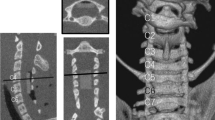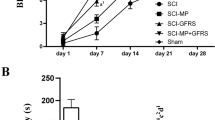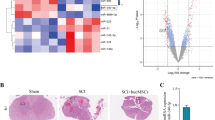Abstract
Study Design:
Experimental, controlled, animal study.
Objectives:
To assess the effects of vitamins C and E (VCE) treatment on oxidative stress and programmed cell deaths after rat spinal cord injury (SCI), as well as functional recovery.
Setting:
Taiwan.
Methods:
Fifty-four Sprague–Dawley rats were used for the experimental procedure. In the sham group, laminectomy at T10 was performed, followed by impactor contusion of the spinal cord. In the control group, only a laminectomy was performed without contusion. Oxidative stress status was assessed by measuring the spinal cord tissue content of superoxide dismutase (SOD) and gluthatione peroxidase (GSH-Px) activities. We also evaluated the effects of combined VCE treatment using western blot to analyze expression of cleaved caspase-3 and microtubule-associated protein light chain 3 (LC3), and the Basso, Beattie and Bresnahan (BBB) scale to evaluate functional outcomes.
Results:
Combined treatment of VCE significantly counteracted the effects of spinal cord contusion on oxidative stress represented by activities of SOD and GSH-Px (P<0.05). The VCE treatment also significantly enhanced LC3-II expression and decreased cleaved caspase-3 compared with the sham (P<0.05). Furthermore, BBB scores significantly improved in the VCE-treated group compared with the sham group (on day 14 and 28 after SCI; P<0.05).
Conclusions:
The combined administration of VCE was clearly capable of modulating the antioxidant effects, and of reducing apoptosis and increasing autophagy at the lesion epicenter leading to an improved functional outcome. Use of such clinically ready drugs could help earlier clinical trials in selected cases of human SCIs.
Similar content being viewed by others
Log in or create a free account to read this content
Gain free access to this article, as well as selected content from this journal and more on nature.com
or
References
Sayer FT, Kronvall E, Nilsson OG . Methylprednisolone treatment in acute spinal cord injury: the myth challenged through a structured analysis of published literature. Spine J 2006; 6: 335–343 Review.
Kayali H, Ozdag MF, Kahraman S, Aydin A, Gonul E, Sayal A et al. The antioxidant effect of beta-Glucan on oxidative stress status in experimental spinal cord injury in rats. Neurosurg Rev 2005; 28: 298–302.
Hickenbottom SL, Grotta J . Neuroprotective therapy. Sem Neurol 1998; 18: 485–492.
Liu TH, Beckman JS, Freeman BA, Hogan EL, Hsu CY . Polyethylene glycol-conjugated superoxide dismutase and catalase reduce ischemic brain injury. Am J Physiol 1989; 256: H589–H593.
Hall ED . Antioxidant therapies for acute spinal cord injury. Neurotherapeutics 2011; 8: 152–167 Review.
Chen HC, Fong TH, Lee AW, Chiu WT . Autophagy is activated in injured neurons and inhibited by methylprednisolone after experimental spinal cord injury. Spine (Phila Pa 1976) 2012; 37: 470–475.
Chen HC, Fong TH, Hsu PW, Chiu WT . Multifaceted effects of rapamycin on functional recovery after spinal cord injury in rats through autophagy promotion, anti-inflammation, and neuroprotection. J Surg Res 2013; 179: e203–e210.
Huang RF, Huang SM, Lin BS, Hung CY, Lu HT . N-Acetylcysteine vitamin C and vitamin E diminish homocysteine thiolactone-induced apoptosis in human promyeloid HL-60 cells. J Nutr 2002; 132: 2151–2156.
Qin F, Yan C, Patel R, Liu W, Dong E . Vitamins C and E attenuate apoptosis, beta-adrenergic receptor desensitization, and sarcoplasmic reticular Ca2+ ATPase downregulation after myocardial infarction. Free Radic Biol Med 2006; 40: 1827–1842.
Karim MR, Fujimura S, Kadowaki M . Vitamin E as a novel enhancer of macroautophagy in rat hepatocytes and H4-II-E cells. Biochem Biophys Res Commun 2010; 394: 981–987.
Martin A, Joseph JA, Cuervo AM . Stimulatory effect of vitamin C on autophagy in glial cells. J Neurochem 2002; 82: 538–549.
Gruner JA . A monitored contusion model of spinal cord injury in the rat. J Neurotrauma 1992; 9: 123–126.
Liu XZ, Xu XM, Hu R, Du C, Zhang SX, McDonald JW et al. Neuronal and glial apoptosis after traumatic spinal cord injury. J Neurosci 1997; 17: 5395–5406.
Cristante AF, Barros Filho TE, Oliveira RP, Marcon RM, Rocha ID, Hanania FR et al. Antioxidative therapy in contusion spinal cord injury. Spinal Cord 2009; 47: 458–463.
Basso DM, Beattie MS, Bresnahan JC . A sensitive and reliable locomotor rating scale for open field testing in rats. J Neurotrauma 1995; 12: 1–21.
Hernandez D, Torres CA, Setlik W, Cebrián C, Mosharov EV, Tang G et al. Regulation of presynaptic neurotransmission by macroautophagy. Neuron 2012; 74: 277–284.
Aiguo Wu, Zhe Ying, Gomez-Pinilla F . Vitamin E protects against oxidative damage and learning disability after mild traumatic brain injury in rats. Neurorehabil Neural Repair 2010; 24: 290–298.
Vaziri ND, Lee YS, Lin CY, Lin VW, Sindhu RK . NAD(P)H oxidase, superoxide dismutase, catalase, glutathione peroxidase and nitric oxide synthase expression in subacute spinal cord injury. Brain Res 2004; 995: 76–83.
Pivtoraiko VN, Stone SL, Roth KA, Shacka JJ . Oxidative stress and autophagy in the regulation of lysosome-dependent neuron death. Antioxid Redox Signal 2009; 11: 481–496 Review.
Burk RF, Christensen JM, Maguire MJ, Austin LM, Whetsell WO Jr, May JM et al. A combined deficiency of vitamins E and C causes severe central nervous system damage in guinea pigs. J Nutr 2006; 136: 1576–1581.
Masaki KH, Losonczy KG, Izmirlian G, Foley DJ, Ross GW, Petrovitch H et al. Association of vitamin E and C supplement use with cognitive function and dementia in elderly men. Neurology 2000; 54: 1265–1272.
Ryan MJ, Dudash HJ, Docherty M, Geronilla KB, Baker BA, Haff GG et al. Vitamin E and C supplementation reduces oxidative stress, improves antioxidant enzymes and positive muscle work in chronically loaded muscles of aged rats. Exp Gerontol 2010; 45: 882–895.
Robert AA, Zamzami M, Sam AE, Al Jadid M, Al Mubarak S . The efficacy of antioxidants in functional recovery of spinal cord injured rats: an experimental study. Neurol Sci 2012; 33: 785–791.
Torres S, Salgado-Ceballos H, Torres JL, Orozco-Suarez S, Díaz-Ruíz A, Martínez A et al. Early metabolic reactivation versus antioxidant therapy after a traumatic spinal cord injury in adult rats. Neuropathology 2010; 30: 36–43.
Acknowledgements
This research was supported by a grant from Chang Gung Memorial Hospital (CMRPG290321). We thank Ms Yu-Tze Lin and Huei-Ting Tsai for technical assistance, and the animal care team at Laboratory Animal Center of Chang Gung Memorial Hospital at Keelung for the animal care in this study.
Author information
Authors and Affiliations
Corresponding author
Ethics declarations
Competing interests
The authors declare no conflict of interest.
Rights and permissions
About this article
Cite this article
Chen, HC., Hsu, PW., Tzaan, WC. et al. Effects of the combined administration of vitamins C and E on the oxidative stress status and programmed cell death pathways after experimental spinal cord injury. Spinal Cord 52, 24–28 (2014). https://doi.org/10.1038/sc.2013.140
Received:
Revised:
Accepted:
Published:
Issue date:
DOI: https://doi.org/10.1038/sc.2013.140
Keywords
This article is cited by
-
Exosomes derived from miR-26a-modified MSCs promote axonal regeneration via the PTEN/AKT/mTOR pathway following spinal cord injury
Stem Cell Research & Therapy (2021)
-
Effects of calcitriol on experimental spinal cord injury in rats
Spinal Cord (2016)
-
Anti-Apoptotic Effects of Dapsone After Spinal Cord Injury in Rats
Neurochemical Research (2015)
-
Wogonin Prevents Rat Dorsal Root Ganglion Neurons Death via Inhibiting Tunicamycin-Induced ER Stress In Vitro
Cellular and Molecular Neurobiology (2015)
-
High-dose ascorbic acid administration improves functional recovery in rats with spinal cord contusion injury
Spinal Cord (2014)



